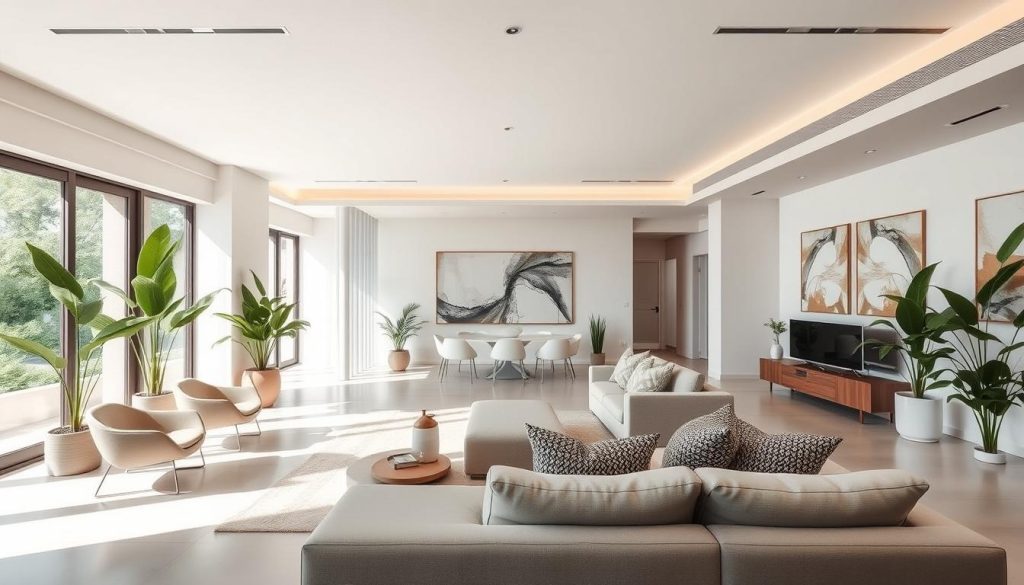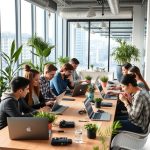In today’s fast-paced world, interior design is key to making homes and offices look great. An expert interior designer can make spaces that look good and work well. They create designs that match the client’s style and needs.
These designers make sure every part of the space shows off the client’s personality. Working with an expert can turn your space into a stylish and comfy place.
Understanding the Importance of Interior Design
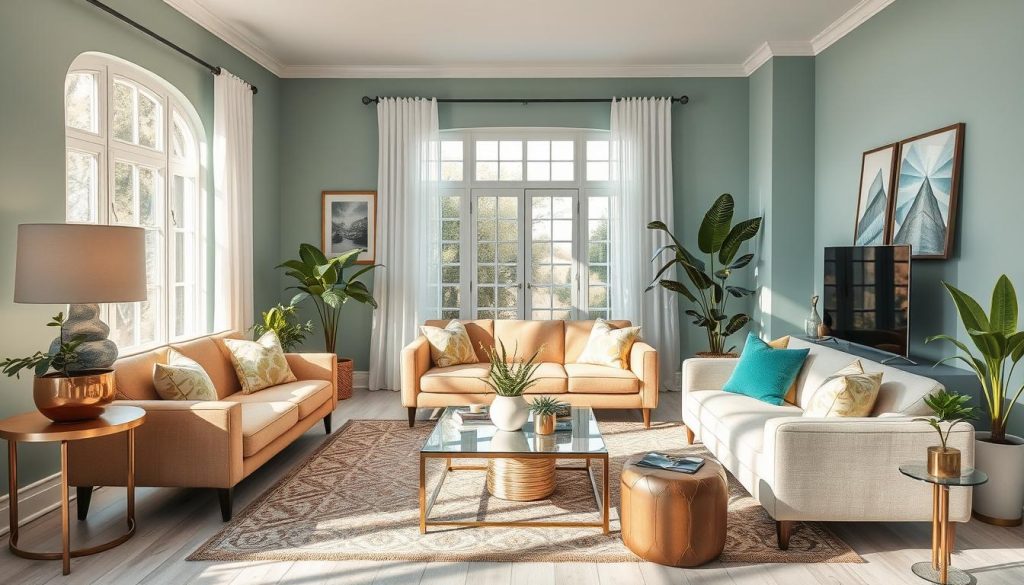
Interior design makes spaces look good and work well. It changes how we feel and think in a room. A well-designed space can make us feel better and more productive.
Design makes spaces more useful. It makes sure rooms are easy to move around in and use. This means homes and offices can be made just right for everyone who uses them.
Studies show that good design helps us stay motivated and focused. For example, adding special design touches can cut down on distractions. This leads to doing better in work and personal life.
Key Principles of Effective Interior Design
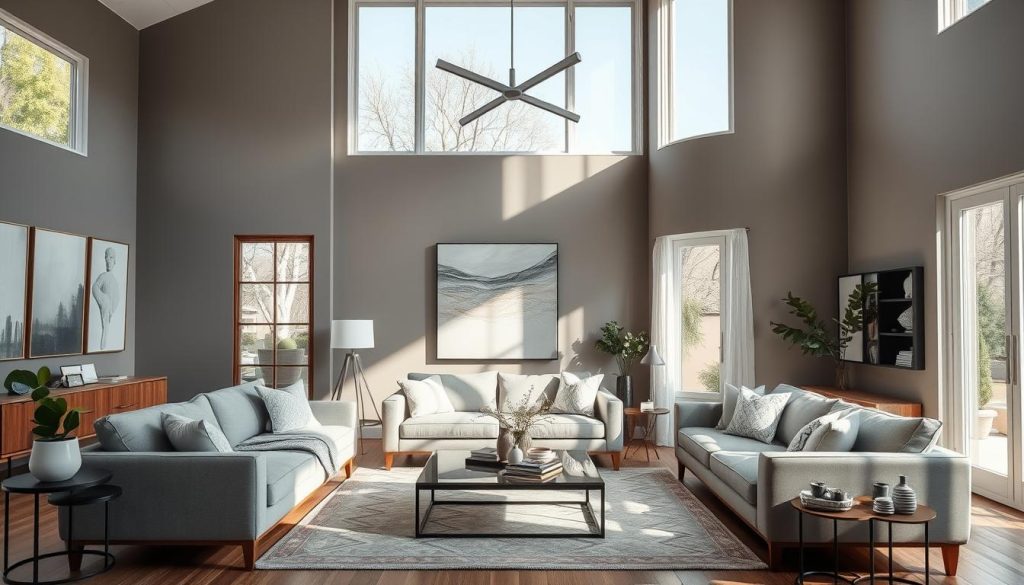
Understanding interior design principles is key to making any space look great. Harmony, balance, proportion, scale, and emphasis are the main ideas that help designers. They make sure the space looks good and works well.
Harmony is vital for connecting different parts of a space. It makes sure colours, shapes, and textures work well together. This creates a sense of unity. Balance is about spreading out the visual weight in the room for a stable feel. You can use symmetrical or asymmetrical designs to achieve this balance.
Proportion and scale are crucial for a realistic and comfortable room. Proportion is about how objects relate in size. Scale is about the size of furniture and decor in relation to the room. Getting these right helps create a space that looks good and is practical.
Emphasis highlights important parts of a room, like a big piece of art or a stylish light fixture. By placing these items carefully, designers can lead the viewer’s eye and tell a story in the space.
These principles can be applied by anyone wanting to improve their home. Begin by looking at your space and seeing what needs work. Whether it’s a single room or your whole house, keeping these principles in mind will lead to a beautiful and functional result.
Benefits of Hiring an Expert Interior Designer
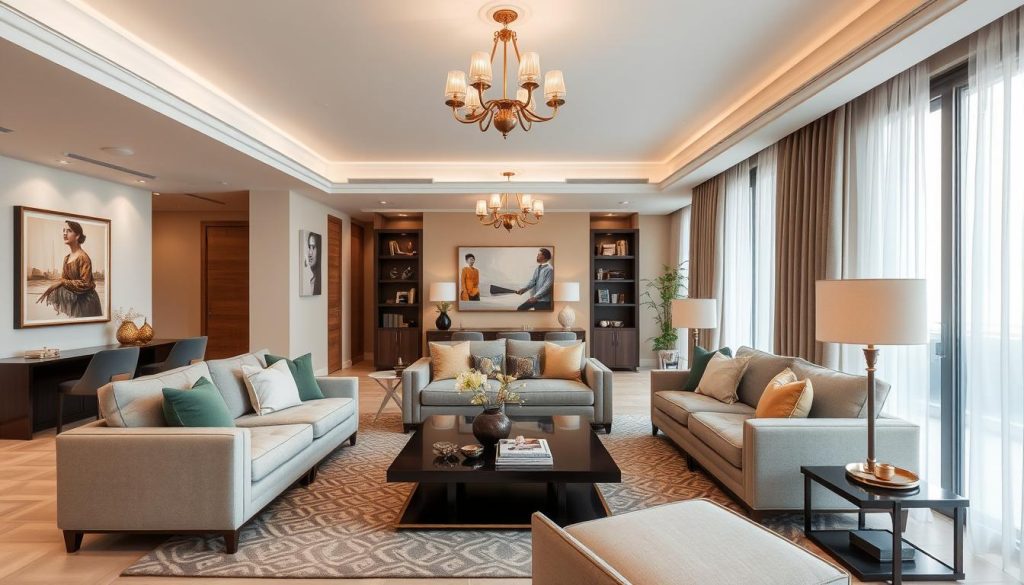
Choosing an interior designer brings many benefits, making your space look better and work better. They know all about the latest design trends and how to use space well. This means they can make a space that shows off your style and uses space well.
One big plus of hiring a designer is they can spot problems before they start. This saves clients from making expensive mistakes. They plan things carefully to avoid mistakes in costs and space use. This makes the project go smoothly from start to finish.
People often say they save a lot of time by working with an expert. These pros handle all the tricky parts of designing, so clients can relax. They also find good deals on materials and furniture, which can save money.
- Enhanced aesthetic appeal through customized designs
- Informed decisions based on current design trends
- Effective management of time and resources
- Minimisation of stress during the design process
In short, hiring an interior designer makes your dream space a reality. They guide you through the whole project, making sure it turns out just right. This ensures the final result meets your needs and dreams.
Interior Design Trends in the United Kingdom
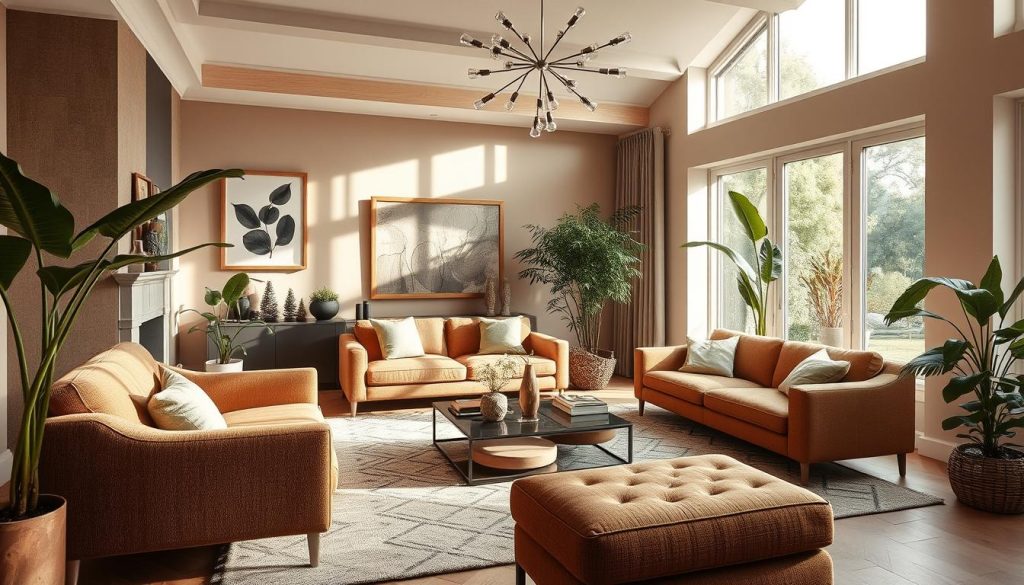
UK interior design trends now mix functionality with beauty. They show off many styles that match different tastes. This makes homes look great and work well.
Biophilic design is big, focusing on bringing nature inside. It uses plants, natural light, and organic materials. This makes spaces calm and fresh. It’s also getting popular because it’s eco-friendly and stylish.
Maximalism is the opposite of minimalism, with lots of patterns, bright colours, and textures. It lets people show off their style with unique art and decor. It’s a top trend for making homes welcoming.
Designers are now creating spaces that do more than one thing. This is because living in cities often means less space. Using versatile furniture and smart layouts helps. It makes rooms look better and use space well.
In short, UK interior design trends are all about being unique, green, and bringing nature inside. They show how we value our own style and the planet.
The Role of Colour in Interior Design
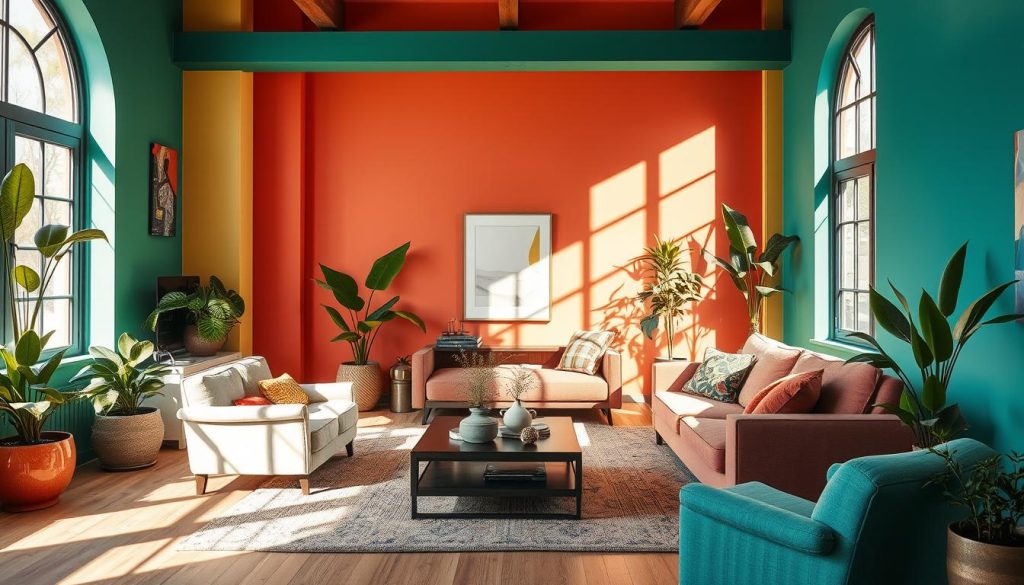
Colour is key in interior design, affecting how a space looks and feels. Choosing the right colours can make a room more functional and stylish. Designers use their knowledge to match colours with the space’s purpose and the people who use it.
Choosing the Right Palette for Your Space
When picking colours, it’s important to mix personal taste with practical needs. Trying out different colour mixes can help achieve the mood you want. For instance:
- Soft pastels are calming, perfect for bedrooms.
- Bold colours like deep reds or blues energise living areas.
- Neutral tones are great for letting other items stand out.
A thoughtful colour scheme ties together different design parts, making the space look unified.
Colour Psychology in Design
Colour psychology looks at how colours affect our feelings and actions. It’s vital for making smart design choices. Studies show that:
- Warm colours, like oranges and yellows, boost energy and warmth.
- Cool colours, such as greens and blues, bring calm and peace.
- Earthy tones create a feeling of stability and trust.
Using colour psychology, designers can make spaces that are not just beautiful but also good for our well-being.
Transforming Small Spaces with Clever Design
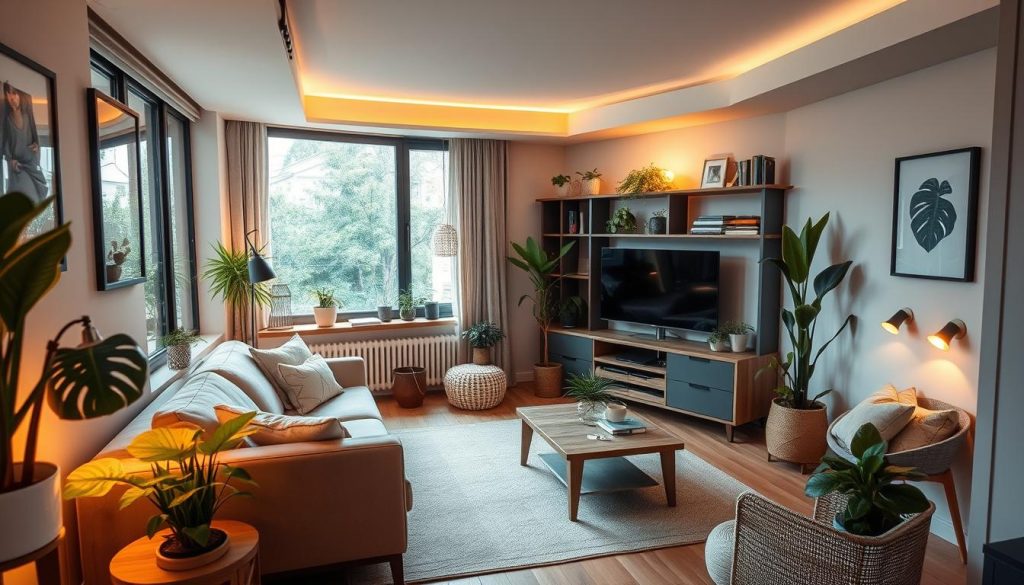
Smart design tricks can really change how small spaces look and work. Using efficient design is key to making the most of these areas. This way, you get comfort and style together. With the right strategies, you can make your living space better through clever design.
Maximising Space Efficiency
When dealing with small areas, focusing on making the most of space is vital. Here are some tips:
- Use vertical storage like shelves and cabinets to make the most of wall space.
- Try using mirrors to make the area look bigger and brighter.
- Choose built-in furniture for a smooth fit in your space.
Choosing Multi-functional Furniture
Picking the right furniture can really boost the use of small spaces. Furniture that does more than one job is a great choice. Here are some examples:
- Sofa beds that turn into beds at night.
- Ottomans with hidden storage for extra space.
- Foldable tables for dining or working, then storing away.
Bespoke Interior Solutions Tailored to Your Needs
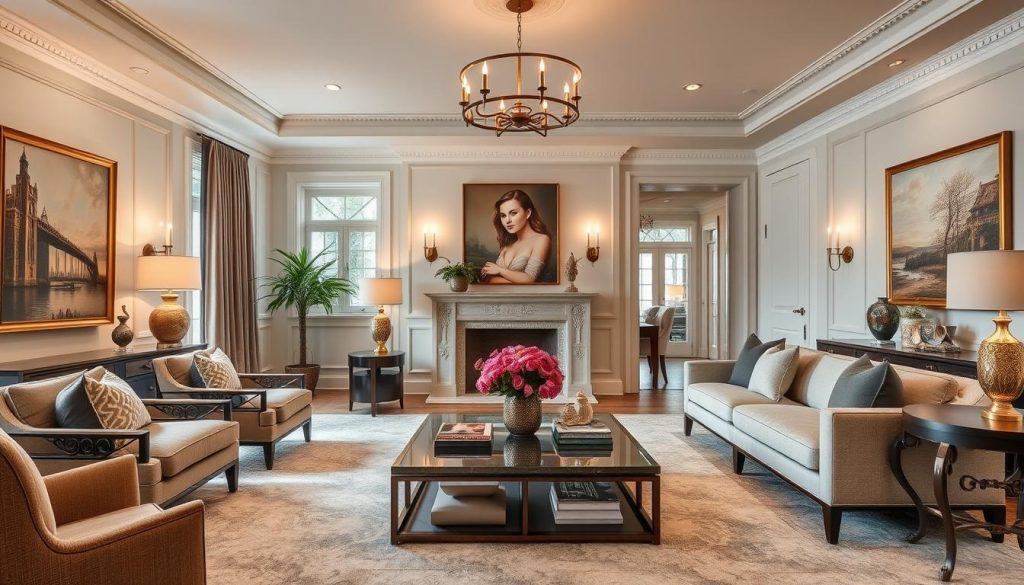
Bespoke interior design offers a unique way to make spaces that match your style and lifestyle. Designers team up with clients to grasp their vision. They then turn spaces into unique interiors that meet the client’s specific needs.
The journey starts with a detailed chat, where the designer learns about the client’s style, what they need, and their budget. This chat is key to making designs that fit the client’s aims.
- Researching client needs to provide tailored solutions.
- Developing custom design proposals based on individual styles.
- Utilising high-quality materials to enhance the overall aesthetic.
- Incorporating innovative ideas that reflect the latest trends.
Many bespoke projects show off the creativity and skill in custom design. These projects range from luxury homes to stylish offices. They prove how smart design boosts both the look and use of a space.
Materials and Textures: Enhancing Your Interior Design
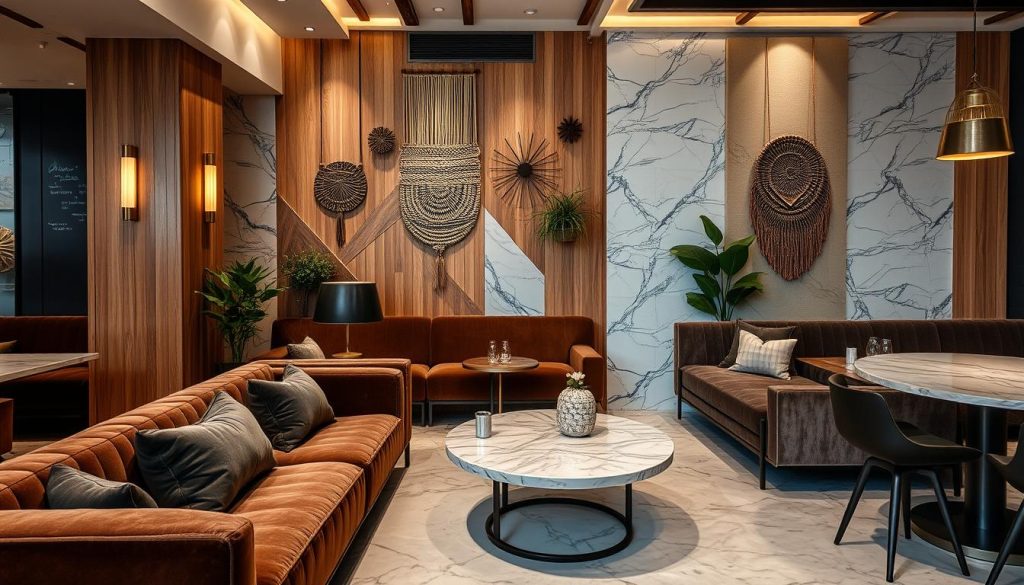
Choosing the right materials and textures is key to making inspiring interior spaces. They affect the look and feel of a room. Modern designs often mix materials for a balanced look that’s both beautiful and practical. It’s important to know about popular materials to improve your space.
Popular Materials Used in Modern Design
Modern design uses a mix of materials for creativity and uniqueness. Some top choices are:
- Wood: Its warmth and flexibility make it great for floors and cabinets.
- Metal: Adds a modern look and can be used in fixtures or as part of the structure.
- Glass: Its transparency and light reflection make it perfect for open spaces.
- Textiles: Fabrics add comfort and softness, great for upholstery and curtains.
Layering Textures for a Cohesive Look
Layering textures adds depth and interest to interior designs. Mixing different textures creates a welcoming atmosphere. Here’s how to layer textures well:
- Mixing materials: Combine soft fabrics with hard surfaces, like plush cushions with a wooden table.
- Varying finishes: Use both matte and glossy finishes for contrast and interest.
- Creating focal points: Highlight textured elements, like a statement wall with textured panels.
Creating a Sustainable Interior Design
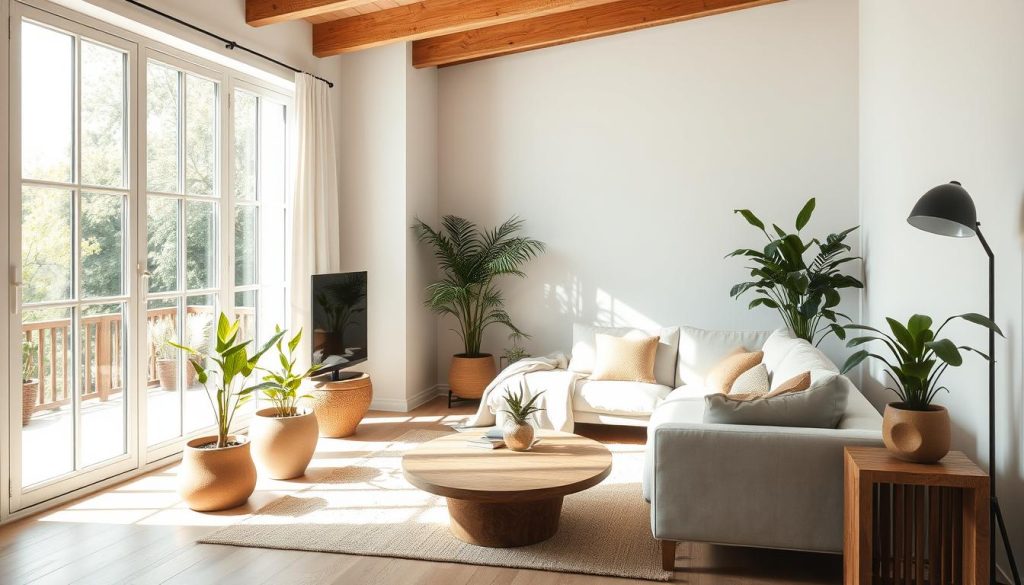
More people now want sustainable interior design because they see its benefits. It’s good for the planet and makes spaces look and work better. Designers use green materials to make sure every part of the design helps the environment.
- Using recycled or reclaimed materials that reduce the need for new resources.
- Incorporating energy-efficient appliances and lighting to minimise environmental impact.
- Implementing designs that optimise natural light, reducing reliance on artificial sources.
- Selecting non-toxic paints and finishes that enhance indoor air quality.
Designers use eco-friendly ideas to make spaces that clients love and that help the planet. They focus on using materials and methods that are good for the earth. This shows how design can be both beautiful and responsible.
Working with an Interior Designer: The Process Explained

Starting a project with an interior designer means going through several steps. These steps make the design process smooth and successful. They help set clear expectations from the start. Below, we’ll look at the key steps and phases of working together.
Initial Consultation Steps
The first meeting is key to the project’s success. It covers important topics such as:
- Identifying the client’s style preferences and inspirations
- Determining the overall budget and timeline
- Understanding the functional requirements of the space
These steps are vital for building a strong relationship between the client and designer. They set the stage for a successful project.
Design and Implementation Phases
The design process moves on to detailed phases. These include:
- Developing design concepts and presenting them to the client
- Selecting materials, colours, and furnishings tailored to the client’s vision
- Overseeing the execution of the design, coordinating with contractors and suppliers
- Ensuring adherence to the agreed timeline and budget
This structured approach in the implementation phases highlights the designer’s role. They bring the client’s vision to life while focusing on practicality and aesthetics.
Showcasing Your Personal Style through Interior Design
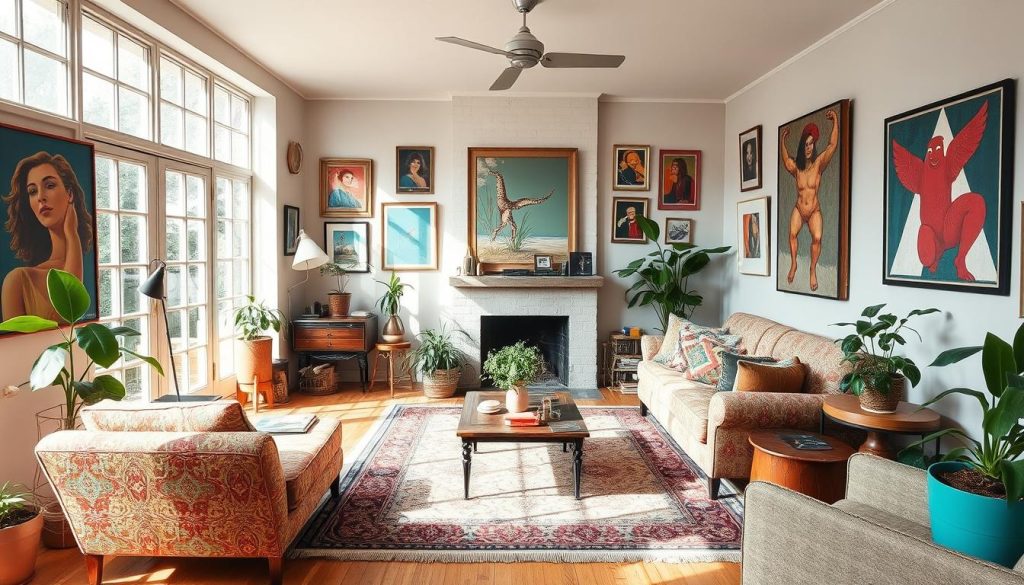
Showing off your personal style in design is key to making a space that mirrors your identity. It lets you express your unique tastes, turning any room into a true reflection of you.
To mix looks with function well, think about these tips:
- Spot the key parts of your design style, like colours, textures, and shapes.
- Add pieces that speak to your unique style. This could be art, furniture, or decor.
- Make sure to balance your personal flair with practical needs. This way, the space looks great and works well.
Looking at various styles, from simple to mixed-up, can spark your own design ideas. Adding your favourite bits can make your space truly yours, showing off your style.
Interior Design for Commercial Spaces

Creating a great commercial interior design means knowing what professional spaces need. The goal is to make spaces that boost productivity and show off the brand’s spirit. Good design choices can turn a workspace into a place that looks good and works well. It shows the company’s values and helps with teamwork and new ideas.
Creating a Professional Environment
Good design for professional spaces looks at many things for both looks and function. Important things to think about include:
- Choosing furniture that is comfy and helps people work better.
- Using the right lighting to make people feel good and work well.
- Having layouts that can change to fit different work styles.
- Choosing colours that match the business’s look and feel.
These things together make a space that’s good for employees and makes a strong impression on clients and visitors.
Branding through Design
Branding in design is key for commercial spaces. It lets physical places share what a company stands for and values. Some ways to do this include:
- Using brand colours in the design to keep things consistent.
- Adding artwork and decorations that show off the brand’s message and culture.
- Making reception areas welcoming to make a strong first impression.
- Using signs that tell the brand story all over the space.
By focusing on design for branding, businesses can make spaces that are inviting and memorable. These spaces have a big impact on both clients and employees.
Common Interior Design Mistakes to Avoid
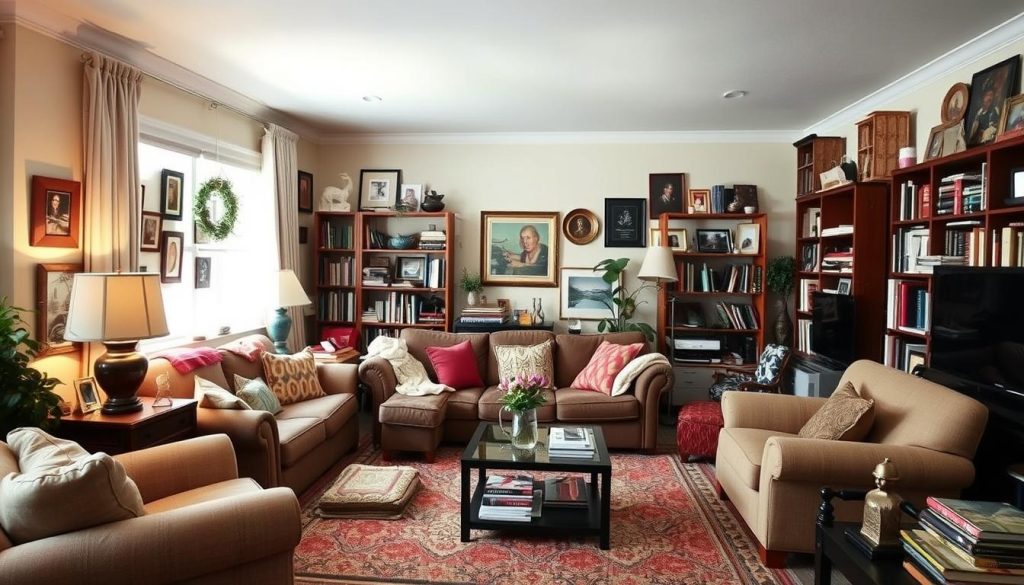
Starting an interior design project can lead to mistakes that affect the look and feel of a space. It’s important to know these common errors to get a great design.
One big mistake is ignoring scale. Picking furniture or decor that’s too big or too small can make a room look cluttered and unwelcoming. It’s key to make sure everything fits well with the room’s size.
Another mistake is having too much stuff in a room. Too many items can make a space feel crowded and take away from its best features. To fix this, use design tips like choosing a few standout pieces that make the room better.
Lighting is also crucial in interior design. Not using enough natural light or not adding the right kinds of lights can make a room dark and gloomy. Make sure to use different types of lighting, like ambient, task, and accent lighting, for the best look.
Planning carefully is key to avoiding design mistakes. Getting professional advice helps spot problems and keeps the design on track. With the right planning, clients can create a space that reflects their style and avoids common design errors.
Budgeting for Your Interior Design Project

Effective interior design budgeting is key to getting your dream space without spending too much. It’s important to know the costs of materials, designer fees, and unexpected expenses. This helps you plan your budget well. Take the time to look at your finances and make a detailed plan to get the most from your money.
Using smart budgeting tips can help you have a design that looks great and works well. Here are some tips to think about:
- Do your homework on materials to find good quality within your budget.
- Focus on what you really want from your design to use your budget wisely.
- Talk clearly with your designer about how much you can spend.
- Save some money in your budget for things you didn’t plan for.
- Look for the best deals by comparing prices from different suppliers and contractors.
By following these tips, you can handle the costs of interior design and still get a look you love. Focusing on cost-effective design means you’ll end up with a space that looks good and feels right.
Finding the Right Interior Designer for Your Project
Starting a design project means finding an interior designer who meets your needs. Begin by looking at their portfolios to see their style and past work. Choose designers whose work you like to make sure they fit your vision.
It’s also key to see how they approach your project. Each designer has their own style and way of working. Make sure their vision matches yours. Talk to them during the selection process to see if they understand your needs. Ask how they plan to make your ideas come alive.
Reading client testimonials and reviews is also helpful. They give you insights into the designer’s reliability, professionalism, and ability to meet deadlines. By considering these factors, you can pick a designer who meets your expectations and improves your space.

